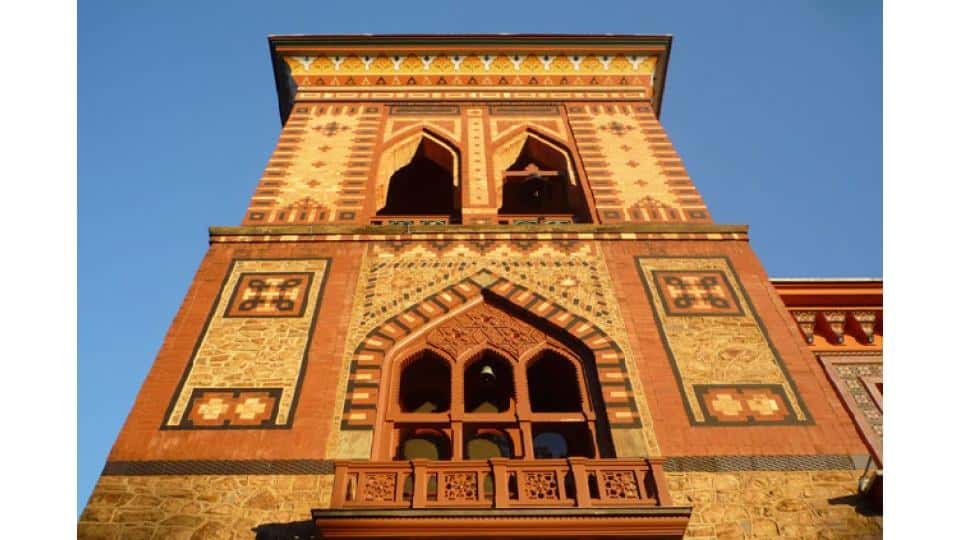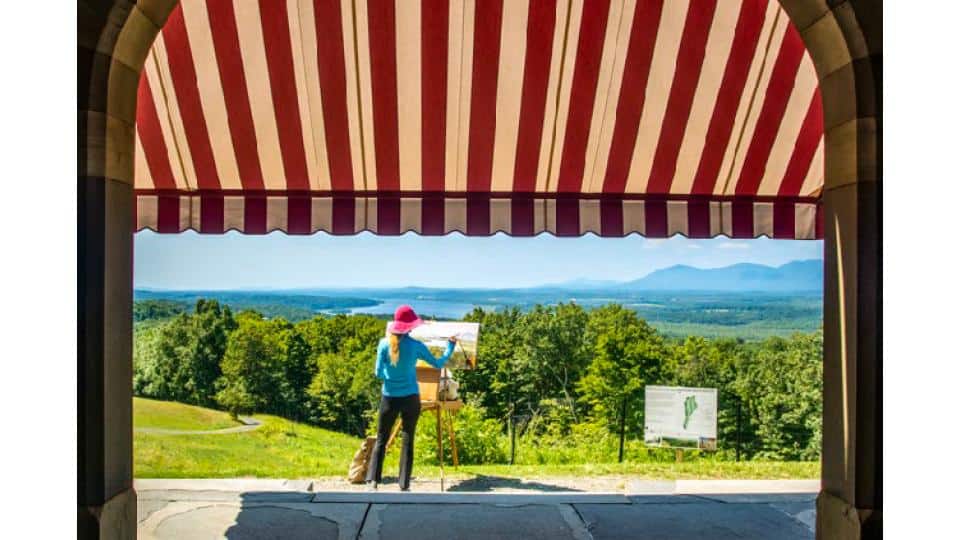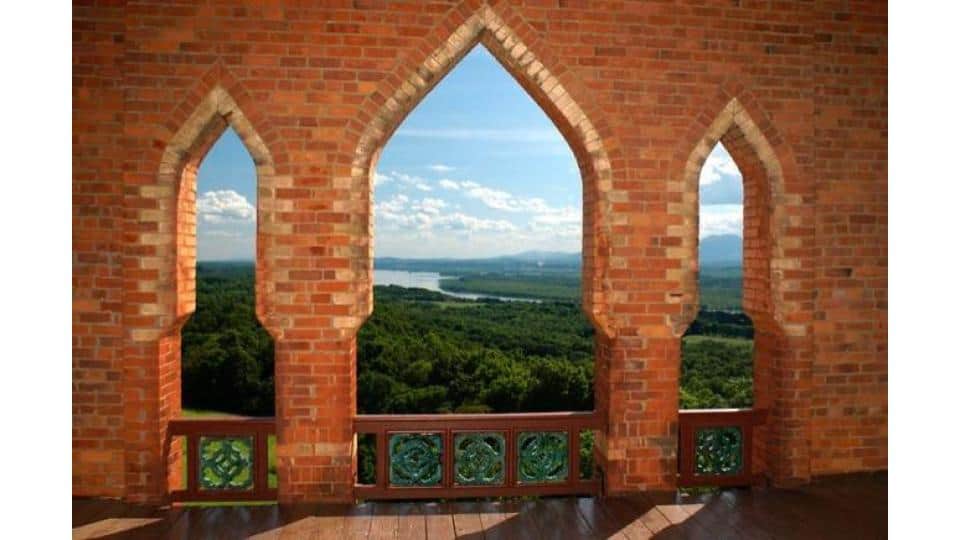“IN FREDERIC CHURCH’S OMBRA” BY BARRY BERGDOLL
Frederic Church’s Olana, created in consultation at the outset with the architect and landscape designer Calvert Vaux, remains — more than 150 years after it was crafted — a powerful statement in the long history of creating a relationship between dwelling and nature. That relationship, one of the leitmotifs of architectural theory since Vitruvius’s Ten Books on Architecture — the earliest surviving architectural text — has been anything but static. Vitruvius compared the human instinct to construct shelter to the activity of certain birds, bees, and other animals who used the materials of nature to create a place at once made from nature and yet offering protection from its most virulent forces.
Two centuries later, the Roman naturalist Pliny the Elder not only described natural phenomena as complexly intertwined, he wrote also of his two villas and the differences they shared with their varied settings. Architecture was to be inflected to a region, a topography, and a landscape, serving also to help cultivate the spirit of contemplation that was the gift of the natural world to those who choose to vacate the city from time to time. Pliny combined descriptions of nature as he observed it and of works of art that communicated those observations. Architecture had already moved from being a refuge from nature to a frame for cultivating relationships with the natural Ombra & Outdoor Rooms realm in all its complexity. Nature was as important to man’s survival as it was to the cultivation of his consciousness of his place in the world, both visual and spiritual. Pliny remained a bedrock reference in the tradition of humanist culture, inspiration for the development of the culture of the villa in the Italian Renaissance and the English country estate in the Eighteenth century, when landscape design and reconstructions of Pliny’s villas from his literary descriptions influenced one another.
Church’s library as it has come down to us includes neither classical author, but he would have encountered Pliny’s importance and reputation in the pages devoted to him in Alexander von Humboldt’s Cosmos, an international best-seller from its first publication in 1845. Pliny’s work ran to 38 volumes and despite its comprehensiveness remained a fragmented vision, in the view of the German natural scientist, the task was to understand and communicate powerfully the organic interconnectedness of all of nature. In critiquing Pliny’s work, Humboldt laid out his own mandate: to conceive a literary form that would encompass the unity of nature not only at any given moment, but through the sweep of time, past, present and future.
![‘Isabel and Downie Church [second from right and rightmost] at the Front Door with Unknown Women,’ c. 1890. Courtesy of Olana State Historic Site, Hudson, New York, Office of Parks, Recreation and Historic Preservation, OL.1987.290](https://olana.org/wp-content/uploads/2024/04/Untitled-presentation-10.jpg)
Such was also the project of Church for whom Olana would be at once a studio for making art and a vantage point for crafting a designed landscape foreground to join in with the portrait of unity painted by nature herself in the vistas the “Persian” castle commanded. Church in a way would synthesize two projects, the architectural guidelines sketched in Calvert Vaux’s handbook Villas and Cottages, published in 1857, with the second volume of the Cosmos, which appeared in a new English translation in New York in 1859. Cosmos evoked in powerful prose the role that landscape painting played in raising human consciousness of the unity of nature. Vaux’s book revealed the reciprocal relationship between nature and architecture in designing a house whose composition and profile would be a suitable addition to a picturesque landscape, even one as grandiose as the Hudson River Valley, all the while considering everything from window openings, bay windows, and porches as places to frame views and create perches for the uplifting pastime of contemplating the spectacle of God’s creation.

Church drew enormous inspiration from Humboldt in everything from the itinerary of his travels in the Andes to his creation of paintings that seem themselves to strive for a form to encompass the notion of the vast unity and interconnection of all aspects of nature, what Humboldt called the Cosmos, even as he traced the equal part of scientists, explorers, and artists in crafting an evolving “Cosmic View.” Olana is, among other things, Church’s response to Humboldt’s two volume masterwork, of which no fewer than three editions survive among Church’s books, still housed atop the hill from which he could survey a panorama of the geology, botany, zoology, and geography of the Hudson Valley, but also his own work in transforming it through the combination of architecture, landscape design, agriculture, and, of course, a house that made the dynamic change of nature framed by his windows every bit as much of the uplifting staging of nature as the display of his paintings in the house’s rooms.

Of all the devices integral to Church’s new house the most important for cultivating thoughts about nature was a varied series of spaces that erode the separation of interior and exterior. Not only were large panes of glass incorporated where possible, and porches appended to the house providing multiple exits from the interior to the exterior, but the space of the “Ombra” literally sits astride the divide of the domestic and the natural; it is at once in the wall of the house and inside and outside that façade. It is the space in which the treasure house of art — drawings, paintings, but also books and objects collected on travels — encounters the spectacle of cultivated and found nature outside. Here one could contemplate alone or discuss together the changes of the weather, the seasons, or even the ways in which the forces of nature over time had shaped the valley of the Hudson, the line of the Catskills, or the contours of Olana’s landscape in the foreground. On the bookshelves of the house Humboldt’s Cosmos could cohabit with editions of the Bible as nature was apprehended both with increased holistic scientific understanding and through the contemplation of God as animating force. Here was the perfect perch for taking stock of the very description of nature that was shared by the Prussian scientist/explorer and the American painter/explorer.

Church died in 1900; and the story of the house in the nearly 120 years since his passing is one in which mankind’s relationship to nature has continued to evolve, sometimes even at the peril of the house and its sublime romantic vision of humanity’s relationship to nature, at once integral part and detached observer, much like the “Ombra” which sits astride and continually challenges any neat divide between nature and culture. The heroic tale of the saving in-extremis of the house and landscape in the mid-1960s is an integral part of the house’s history, but the challenges have continued. In 2011 a proposal for a gigantic coal-fired cement plant to be built just north of Olana reminded us again of the fact that Church’s vision of the natural sublime was developed just as the industrial revolution was hitting its stride in America. Coal was at once a reminder of the prehistoric formation of the earth’s crust and an agent for mankind’s ability to change the very unity of nature Humboldt set out to describe even as everything from industrial plants to railroads was changing both the landscape and mankind’s relationship to nature. That human-induced change of what Church would have understood as the natural order has led many to claim that today we live in a wholly new period in the history of planet earth, the Anthropocene. Olana’s rescue in the 1960s coincided also with the origins of the environmental movement, motored by consciousness raised at Woodstock not far away to the first celebrations of Earth Day in 1970.

Olana today is at once a record of the mid-19th century’s vision of crafting a relationship to nature and a perch for thinking about how the challenges of the interface between human culture and nature — one that has as fluid a boundary as the Ombra does between Church’s family refuge and his spectacle of nature — can be addressed. It is in that spirit that this exhibition was conceived not as a display of the historical past but as an engagement of a group of invited architects, artists, and designers with both Olana’s historical presence and the epochal shifts underway in our relationship to nature. The projects presented here are a first response to a brief that will grow in urgency in coming years, and which also reminds us that, as a living heritage, Olana is not only a place to discover Church but to begin to contemplate anew our place within nature.
Barry Bergdoll is Meyer Schapiro Professor of Art History at Columbia University and a curator in the Department of Architecture and Design at the Museum of Modern Art, New York. A specialist in the history of modern architecture, he has curated numerous exhibitions at MoMA, the Canadian Centre for Architecture, the Musée d’Orsay, and other venues, including Mies In Berlin (2001), Bauhaus 1919–1933: Workshops for Modernity (2009-2010), Latin America in Construction: Architecture 1955-1980 (2015) and Frank Lloyd Wright at 150: Unpacking the Archive (2017).
He is the author most recently of Marcel Breuer: Building Global Institutions (2017), and many other publications including La structure mise en lumière – Henri Labrouste (1801-1875) (2012), European Architecture 1750-1890 (2000).

